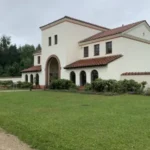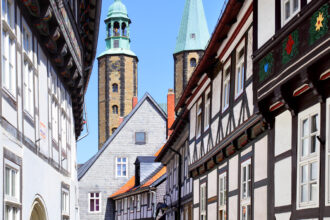In Mauerbach, a market town near Vienna, I discovered a former monastery of Carthusian monks who once lived there in silence and abstinence. The early Baroque Mauerbach Charterhouse is one of the most important of its kind in Austria and has the longest cloister in Europe. I went there to explore the monastery complex and the parish church. First, I saw the Prima Porta, consisting of an outer and inner gate. The outer gate was built in 1639 with the Mauerbach coat of arms, and the inner gate was built in 1645 from red Gaminger marble. A special feature of the outer gate is the gable-like structure with a round-arched niche in which a holy image is painted, depicting St. Bruno and St. Anthony, both worshipping the crucified Christ. God the Father can be seen above the crucified Christ. Below, in the masonry, a Latin inscription has been added, providing information about the founder and the year the Carthusian monastery was founded. The monastery was founded by King Frederick the Fair in 1314. After the monastery was dissolved by Emperor Joseph II during the Josephine reforms, the Carthusian monastery was used from 1784 onwards as a care home for the elderly and terminally ill in the municipality of Vienna. From 1944 to 1961, it housed a homeless shelter. In 1961, the Carthusian monastery became federal property and underwent extensive renovation from 1968 to 1971. From 1984 to the present day, the monastery complex has been used by the Federal Monuments Office and its restoration workshops. After a short walk, I arrived at the parish church of the Assumption of Mary. This former gate church of the Carthusian monastery was probably built on the site of the church of St. Mariae ad piscinas. It served as a place of worship for the infirmary, which had been founded by Gerlach, King Frederick’s court chaplain. The gate church was intended for monastery servants and pilgrims. After the Carthusian monastery was dissolved, full parish rights were transferred from the older church on Allerheiligenberg to Mariae Himmelfahrt. The parish house attached to the church was destroyed by flooding in 1785, along with all the parish records. Consecrated in 1945, the two-bay wall pillar church is decorated with rich high baroque stucco and ceiling moldings from the 1720s. I was particularly impressed by the high altarpiece depicting the Assumption of Mary by Johann Georg Schmidt from shortly after 1720. Another highlight is the altar and pulpit created by Matthias Steinl, which are richly decorated with sculptures and ornamental elements. Thanks to the initiative of the Federal Monuments Office, the parish church and the Carthusian monastery in the Vienna Woods now shine in new splendor.
























